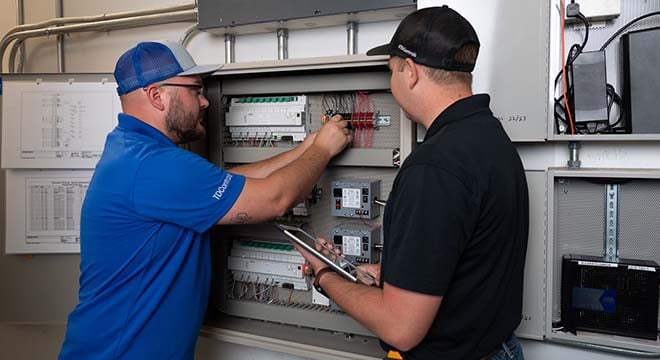
Your roles and responsibilities in building operations and maintenance have never been more essential. Your job is to sustain and optimize the performance of a building according to its documented design intent and the owner’s operational requirements. That isn’t as simple as it sounds.
Most of us continue to do more with less. That includes maintaining equipment efficiency amid rising energy costs and to meet sustainability goals; ensuring indoor air quality; and prolonging equipment life to get the most out of your annual budget. As you strive for top operational performance, don’t let any of these five common myths about building automation and controls hold you back.
Myth No. 1. When choosing to change out or upgrade your building controls system, you have to stick with a proprietary vendor.
You may have inherited a proprietary brand building controls system or worked only with a single product line that has so far served your company well. Yet you discover when looking to upgrade an aging or outdated system or are expanding your system to new construction that more flexible options might better suit your company moving forward.
Investing in a new system does not tie you to one provider, and new equipment can be retrofitted to work with your original setup in most cases. Look for a contractor or vendor that offers an open distribution model such as Tridium Niagara.
With open-protocol standards, your system is vendor agnostic. You have all the tools you need to use the vendor of your choice for service or support. Choose a Controls provider because you value their expertise, brand options and open platform, not because you “have to.”
TDIndustries’ Controls offers top-tier brands Siemens, Tridium and Distech in Texas and Siemens and Tridium in Arizona for your new or retrofit project.
Myth No. 2. Controls updates and retrofits require budget approval for a large, capital expenditure with work completed within the budget year.
Don’t let budget limitations or capital expenditure red tape discourage you from making necessary upgrades.
Waiting to make improvements on an inefficient system can cost your company more than you realize, including increased utility costs, the risk of equipment failure and expensive emergency maintenance, or even potential setbacks related to industry standards noncompliance.
TDIndustries regularly helps organizations negotiate funding challenges by offering:
- Retrofit packages that can be planned out over multiple years, with energy savings along the way
- Discounts through pre-vetted cooperative agreements
- An introductory audit or system diagnostics (for qualifying Texas and Arizona companies) to get started
Myth No. 3. Building Automation Systems require a large in-house support team and drive up operating costs.
The reality is quite the opposite. A well-engineered building controls and automation system helps you manage the following, often remotely, with a small team:
Energy & Comfort: Keep tenants comfortable while maximizing the efficiency of your building’s HVAC, lighting and mission critical systems.
Maintenance & Monitoring: Quickly adapt to the unique needs of your facilities with monitoring to provide proactive and planned maintenance while reducing labor costs and overhead.
With minimal maintenance staff, you’re able to quickly analyze your building systems’ performance at the tip of your fingers.
Myth No. 4. Federal sustainability or infrastructure funding doesn’t apply to building controls updates.
TDIndustries, in coordination with cooperative organizations, can work with you to take advantage of federal funds to support improvements in ventilation, filtration and clean indoor air quality by implementing sequences of operation that optimize HVAC systems.
Our engineers and technicians are ready to incorporate your long-term needs in a strategic, phased approach to work with your budget. If you haven’t yet taken advantage of state or federal funding opportunities, TD can help get you started through cooperative organizations.
Myth No. 5. A Controls system doesn’t require regular maintenance for optimal performance.
It’s fairly common for building operations teams to verify setpoints once per season. However, the performance of the entire building automation system, along with its physical components, is sometimes neglected. If a team has had a lot of turnover, it’s also possible that many systems could be grossly underutilized due to a lack of understanding or training of how the system was originally set up.
It’s important to regularly maintain, update and adjust your building controls system to adapt to current conditions to increase performance and proactively address signs of equipment failure that could result in preventable and expensive emergency repairs. Regularly reviewing data and creating backups can mean less downtime for your company in the event of equipment failure.
Common items to check include:
- Visual inspection of controller, valve and actuator
- Visual inspection of all wiring and terminations
- Check configuration of controller to ensure optimum performance
- Dismantle control valve, clean and visually inspect valve internals
- Check and clean all strainer screens, re-fit using new cap gaskets
- Set valve/actuator/positioners, zero and stroke
- Functionally test to ensure correct operation and satisfactory temperature/pressure control
- Check calibration of temperature, humidity and flow sensors
- Clean out air flow measurement equipment
- Upgrade graphical interface for equipment relocations and adjustments to floor layouts
- Test safety interlocks to verify performance
--------------------------
TDIndustries installs, retrofits, supports and maintains Building Automation and Controls systems in all industries across the Southwest. We’re here to help you when you need it.
If any of these myths hit close to home, schedule an audit or consultation with an experienced TDIndustries adviser today.
More from the Blog
When and How to Change Out Your Small HVAC Units
Small HVAC unit changeouts can be stressful because you never really know when they’re coming. Without...
Why Summer HVAC Maintenance Is Essential for Your Business
Extreme summer temperatures are on the rise, but your maintenance and repair costs don’t have to be. ...
Using Facilities Management to Improve Efficiency
While some history buffs may contend that the work of a facilities manager dates back to the development...
Subscribe to our blog
Please provide your email address to subscribe!
